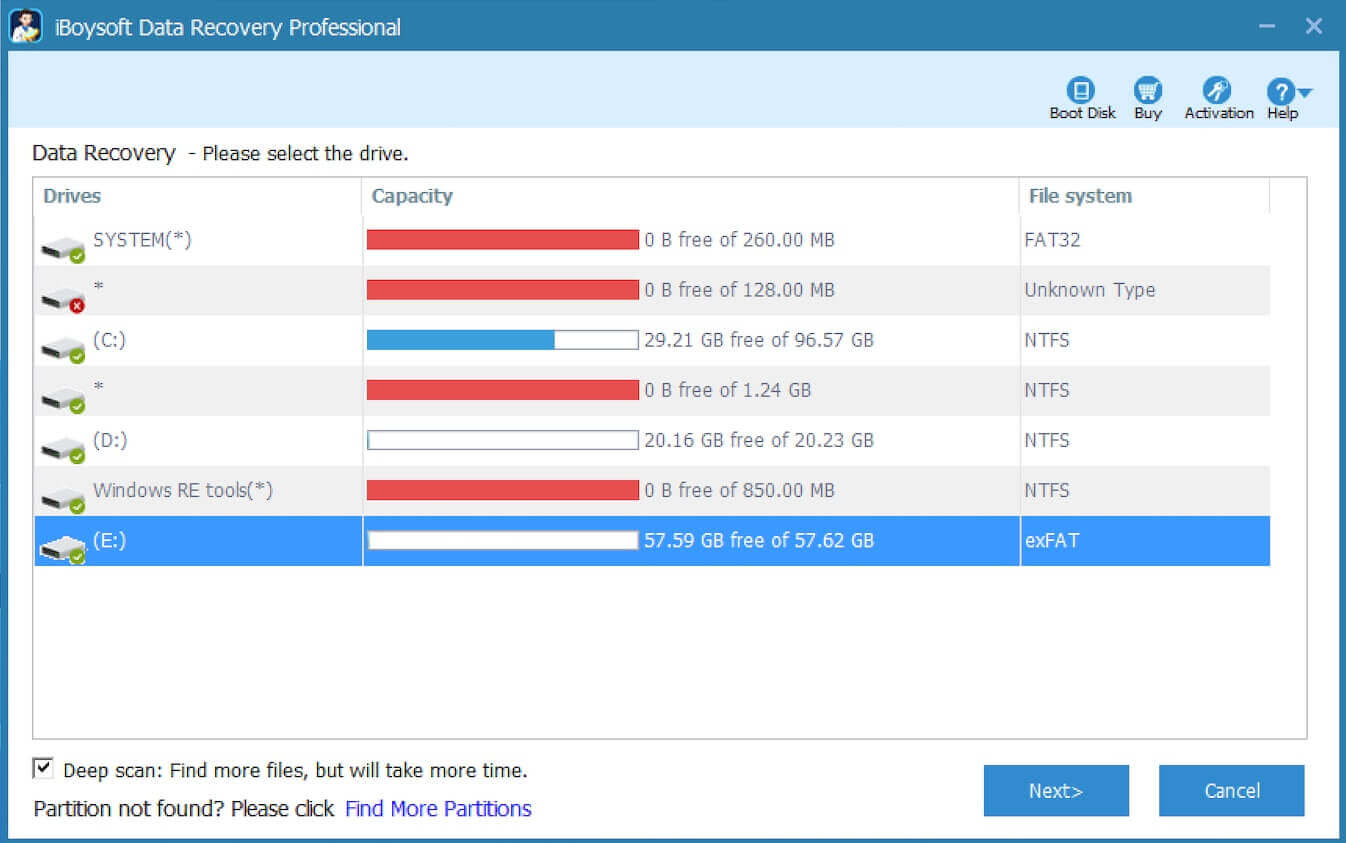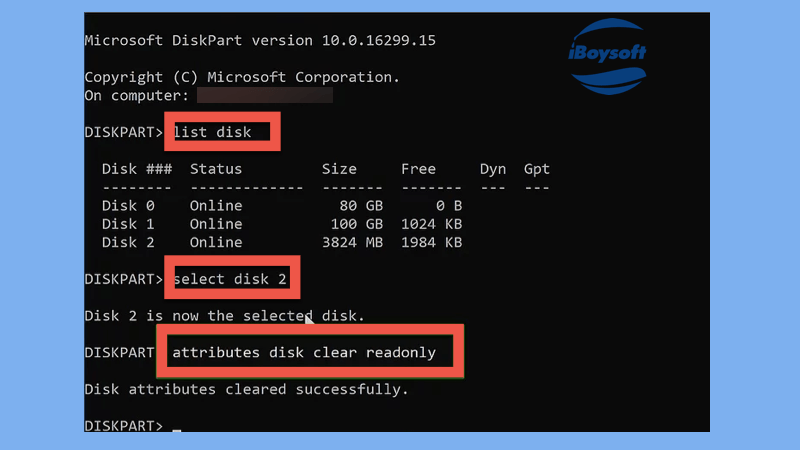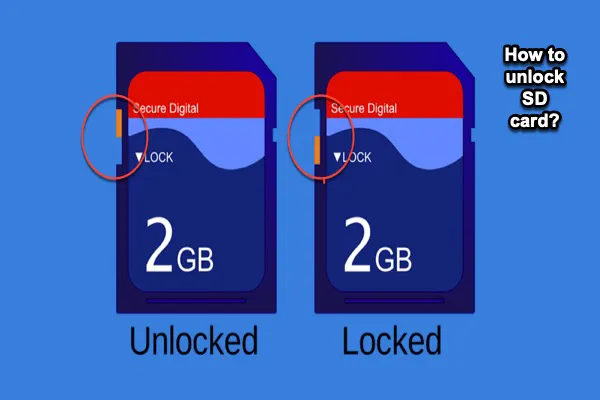Disabling a write-protected SD card in the first place is a way to protect your files from accidental deletion or disk erasure. When you need to write to or format a write-protected SD card or micro SD card, you will receive an error message stating "The disk is write protected" on a Windows PC, "Memory card locked" on cameras, or "read-only" on a Mac.
In order to make the micro SD card writable, you need to remove write protection from SD card. In this post, you will learn 8 methods on how to get rid of write protection on SD cards without data loss.
Prior thing: Backup or Recover Data Before Removing Write Protection
Before proceeding to remove write protection from your SD card, it's crucial to ensure your important files are safe. In some cases, the write protection may be caused by file system corruption, physical damage, or other underlying issues. If you try to format or modify the card without securing your data, you could suffer irreversible data loss.
If you're unable to access or copy files from the SD card, consider using professional data recovery software like iBoysoft Data Recovery for Windows. It can scan the write-protected SD card and help recover photos, videos, and documents before you apply any fixes.
Let's do a data recovery with iBoysoft Data Recovery:
- Free download, install, and open it on your PC.
- Choose "Data Recovery", select the SD card, and click "Next".

- Wait for the scan, then preview the files.
- Select the wanted files and click "Recover" to save them to another location.
Have you got this preparation? Please share it with others.
#1 Unlock the SD card by sliding up the physical SD card lock
Basically, all SD standard cards have a physical write protection switch that can be toggled up to disable write protection on micro SD card. Hence, when a micro SD card/SD card is write-protected, the first thing to check is the physical lock position.
If you find the SD card unlocked but the card is write-protected, it could be a bad connection that prevents you from writing to the SD card.
#2 Clean SD card's metal connectors
For a micro SD card or SD card write-protected but not locked, take a close look at the metal chips on the SD card or micro SD card. They are supposed to connect to a digital device that should be flat, clean, and dry. If the SD card's metal contacts are dusty, oily, or covered with an oxidized layer, it might be "protected" from writing.
Use a piece of soft and dry cloth and wipe the connectors gently, or clean them with a piece of cotton moistened with alcohol if they are oily. Also, you can use an eraser to get rid of that oxidized layer or stains.
If the metal connectors are scratched or flaked off, there is no need to remove write protection on the micro SD card but to replace the entire storage media.
After checking the lock and connectors, you can't write to the SD card? Try the following solutions to remove write protection from the SD card.
#3 Disable write protection on SD card by third-party software
Standard SD cards or micro SD cards could be protected by a password using mobile devices or third-party software from unwanted data modification. In this case, you need to recall if you have locked your SD card/micro SD card with an encryption tool (such as SanDisk micro SD card Secure Access) or any write protection software.
If so, remove write protection on micro SD cards with the correct password using that specific software.
Successfully get SD card write protection removed? Share this post to help more people!
#4 Clear read-only attributes on SD card
In some cases, the write-protected SD card has only read permission. Such digital write protection on a micro SD card could be removed using Diskpart on Windows 10/8/7. In macOS, an admin account may set up a read-only privilege to this SD card/micro SD card, making it a write-protected SD card; you need to take over the admin rights to edit the privilege.
So, if you are using a PC, make sure you are the administrator and carefully follow these steps to get write protection on the micro SD card removed:
- Click the Windows logo or Start in the bottom-left corner of your desktop.
- Type in: “command prompt for search and run Command Prompt as an administrator from the results.
- Type in: diskpart into Command Prompt, followed by pressing the Enter key.
- After allowing it to make changes, type in: list disk and press Enter.
- Locate your SD card according to the disk information and remember its disk number.
- Type in: select disk number and replace "number" with your SD card's, then press Enter key.
- Type in: attributes disk clear readonly and press Enter.

Your SD memory card won't have the write-protected error after you see the "Disk attributes cleared successfully" message in the command prompt window.
If you are using a Mac, you need to follow these steps to fix a SD memory card write protected:
- Right-click the SD card/micro SD card icon on the desktop or in Disk Utility and select Get info.
- Scroll down to find Sharing & Permissions.
- Click the yellow lock to make changes and enter your admin password.
- Select your user name and change from Read Only to Read & Write.
- Click the yellow lock again to save the change.
If the write protection still can't be removed after read-only permission is disabled, you may need to go deep to modify the Windows registry to remove write protection on the micro SD card.
#5 Edit the Windows Registry to fix the SD card write-protected
Be careful when you are editing the Windows Registry. Back up your memory card first.
- Keep your SD card/micro SD card connected to the Windows computer.
- Use Windows + R together to open the Run window.
- Type in regedit and press Enter to open Registry Editor.
- Expand the folder in the left panel as the following path: HKEY_LOCAL_MACHINE\SYSTEM\CurrentControlSet\Control\StorageDevicePolicies. If you don't see the StorageDevicePolicies folder, right-click Control folder and select New > Key to create a new key called StorageDevicePolicies.
- Right-click the StorageDevicePolicies folder and click New > DWORD (32-bit) Value to create a new value named WiteProtect.
- Double-click the WriteProtect key in the right window and set its value data to 0, and click OK.
- Close Registry Editor, disconnect the SD card, and restart your PC.
If all attempts above don't help remove write protection on the micro SD card or SD card, you need to check if the device's file system is corrupted.
SD card writable now? Share this post to help more people!
#6 Repair corrupted file system that prevents write permission
It's possible that you can't write to the SD card because parts of your SD card (that are related to writing permission) are corrupted. Then, you'll need to repair such corruption to regain write access to this SD card.
On your Windows PC:
- On your Windows PC, find your SD card in File Explorer and right-click on it.
- Choose Properties in the context menu.
- Choose Tools and then click on the Check button.
Such an SD card repairing process could also be completed with Mac's First Aid. Once the error scanning and repairing process completes, you can reinsert your SD card or micro SD card to your device and access it again.
• How to repair SD card with First Aid on your Mac?
If the write-protected SD card error can't be repaired, you need to recover data from the corrupted SD card and then format the SD card to make it work again.
#7 Recover data and reformat write protected SD card
Formatting an SD card or micro SD card will force remove write protection on micro SD card caused by a corrupted file system. Before you reformat a write-protected SD card or micro SD card, do remember to back up your important files by recovering them from the corrupted SD card using reliable data recovery software.
• How to recover data from corrupted SD card on Windows?
• How to recover data from SD card on Mac?
After files are recovered, go ahead to format SD card with free tools.
• How to format an SD card on your Mac?
#8 Replace with a new SD card
If the SD card still can't work right, you may have to get a new SD card or micro SD card for your device.
Conclusion
After reading this post, you know how to remove write protection from SD card or micro SD card, then you'll be able to take new pictures using the SD card in cameras, transfer files from computers to the SD card, and do any operations to this SD card including formatting.

[Proved] 5 Solutions to Fix the SD Card Read Only Error
This article offers five effective and easy solutions to fix the SD card read only error, and helps you change your read only SD card back to normal. Read more >>
Think this post is helpful? Share it with more people!
- QWhy does my SD card say write protected?
-
A
Because you have enabled the write protection on the SD card. With this feature of the SD card turned on, it prevents the data stored on it from being deleted or overwritten.
- QHow do I unlock a write protected SD card?
-
A
There is a physical switch used to protect the SD card. To unlock a write-protected SD card, you need to shift the switch in the opposite direction and reconnect the SD card to the computer.
- QHow do I make my SD card writable?
-
A
You can follow the methods we provide in this post one by one to remove write protection from SD cards or Micro SD cards, including using the physical switch, checking the connection, utilizing third-party software, clearing read-only attributes, editing Windows Registry, etc.
